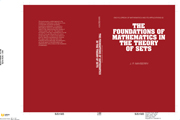Book contents
3 - Semantics, Ontology, and Logic
from Part Two - Basic Set Theory
Published online by Cambridge University Press: 05 March 2012
Summary
Objects and identity
Arithmetic has taken over the whole of mathematics: not the arithmetic of natural numbers, but the generalised and refined version of classical, Greek arithmetic that we now call set theory. But if it is present everywhere, its presence usually goes unnoticed. Indeed, it is most successful when it is least conspicuous, for its essential role is a logical one, so that it appears to the mathematician practising his trade simply as a collection of tools which enable him to get on with his real job – algebraic geometry, functional analysis, or whatever it happens to be.
Its most important function is to provide the logical foundations for the axiomatic method, which is the central method of modern mathematics. When we lay down a system of axioms (e.g. the axioms for groups, or for real numbers), we are defining a class or species of mathematical structures (the species of all groups, or the species of all complete ordered fields). We must therefore say, exactly, what these “structures” are, and that is where set theory comes in. For the raw materials out of which such structures are manufactured are sets.
In fact, since the axiomatic method only allows us to define our structures up to isomorphism, the particular objects that go to make up the universe of discourse of a structure make no contribution to the structure's mathematical properties – only the size (cardinality) of that universe is mathematically relevant.
- Type
- Chapter
- Information
- The Foundations of Mathematics in the Theory of Sets , pp. 67 - 110Publisher: Cambridge University PressPrint publication year: 2001



